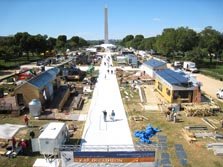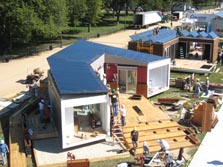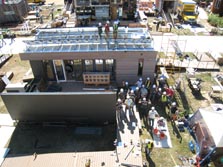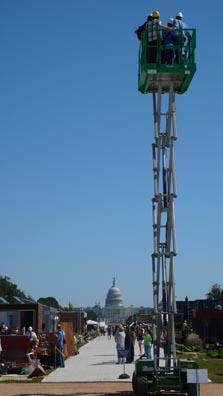
Click photo to view high-resolution image.

A view of the solar village and Decathlete Way, which runs the length of the competition houses.
(Credit: Richard King/U.S. Department of Energy Solar Decathlon)

Team members install a second skin on the exterior of Team California's Refract House, which is a bent tube that wraps around a central courtyard.
(Credit: Richard King/U.S. Department of Energy Solar Decathlon)

Team Boston pauses during assembly of Curio.House to wave at Richard King in the scissors lift.
(Credit: Richard King/U.S. Department of Energy Solar Decathlon)

Accompanied by members of the media and Team Boston decathletes, Event Director Richard King gets a bird's-eye view from a scissors lift.
(Credit: Angel Borrego Cubero/U.S. Department of Energy Solar Decathlon)
Solar Decathlon 2009
Daily Journal - October 4, 2009
Solar Decathlon Class of 2009: Workforce of Tomorrow
The work accomplished in the solar village is just incredible. This is clearly the largest construction site Washington D.C. has seen in a long time. At today's morning meeting, we estimated 22 team members, on average, are involved with the on-site assembly of each house, which totals approximately 450 hard-working participants on the National Mall. Of course, many more people—including architecture, engineering, business, communications, interior design, and even horticulture and culinary students—have contributed to the projects over the past two years. The average team size is 150, for a total of about 3,000 team members.
What an amazing workforce! Each lot is a beehive of activity. Everyone is working toward the common goal of finishing by Wednesday, Oct. 7. The team members have assigned duties and deadlines, which are carefully orchestrated by their project managers. If you look at our time-lapse cameras, you can literally watch the village being built before your eyes. We are proud and impressed with each and every decathlete.
Awareness of the energy and climate challenges that confront our nation and the world has increased. But these decathletes have not only awareness but also passion and initiative. The two-year projects require dedication, resourcefulness, and perseverance. The Solar Decathlon is an invaluable learning experience from which we all benefit. The Solar Decathlon is producing a well-educated workforce of 3,000 decathletes who will become our energy leaders of tomorrow. Some would argue they already are.
One of the best ways to experience the village during the construction phase is from a scissors lift. Team Boston accompanied me on a loop around the site to witness the activity from 35 feet in the air. From that vantage point, the PV panels and solar electric system configurations are clearly visible. Refract House from Team California is essentially a rectangle bent in two places to create living spaces. From the lift, I could better appreciate the shape of the house. Cornell's Silo House is also interesting. At ground level, the house is dominated by the round design of the silos. But when you see it from above, the design is dominated by the floating PV array. Some of the houses, such as Team Germany, have PV systems that are flat or low-profile, so you can't see them unless you get up high. The scissors lift was the perfect opportunity.
